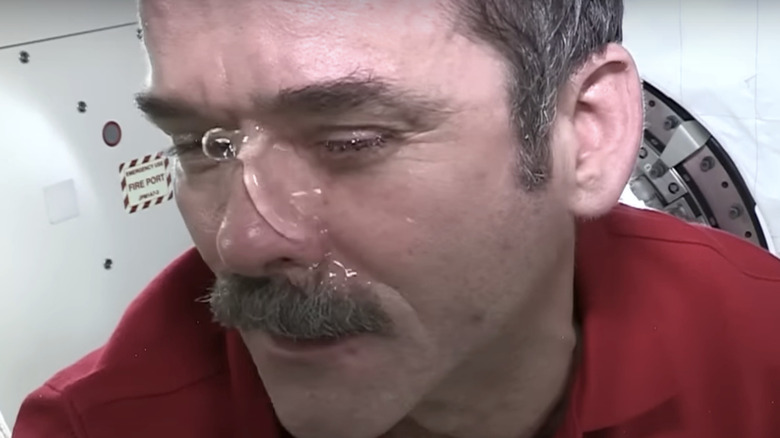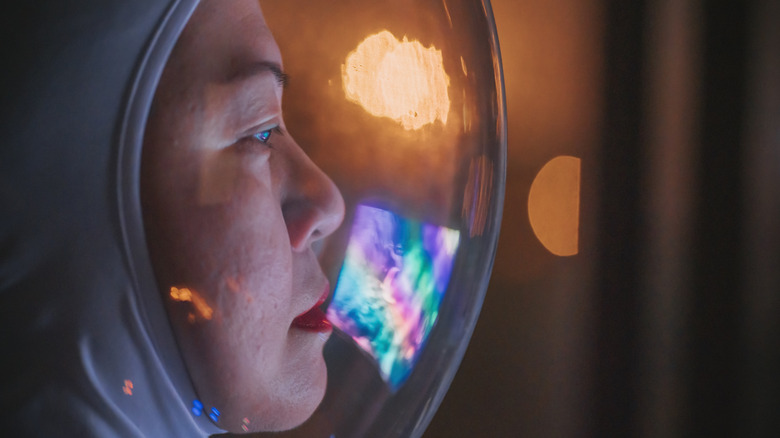What Happens When Astronauts Cry In Space
Though crying is understood generally as a way for the body to restore an emotional balance, it's still somewhat of a mystery, but what would it be like if we couldn't actually shed tears, say in a zero-gravity environment? After all, astronauts obviously don't cease being human when they embark on their space expeditions. And it's certainly likely they may feel the need to have a quick cry from time to time, especially when experiencing something as monumental as traveling to space and seeing the Earth from orbit. Well, it turns out, they sting a bit, and they certainly don't roll down your face.
Back in 2013, over on X (formerly Twitter), International Space Station commander and Canadian Space Agency Astronaut Chris Hadfield was asked if he could cry in space. He responded, "Can you cry in space? Your eyes make tears but they stick as a liquid ball. In fact, they sting a bit. So — space tears don't shed."
Tears don't drop in space, but in fact, they sting a bit
Why tears might sting in space isn't entirely clear, though as one 2023 study published in Frontiers in Psychology notes, dry eye disease is actually one of the most common eye conditions experienced by astronauts with more than 30% of International Space Station expedition crew members reporting irritation and something called foreign body sensation, which refers to the feeling of having an object stuck in your eye. As such, tears introducing moisture to a dry cornea might explain the "sting" that Hadfield referred to.
Also in 2013, Hadfield posted a video where he demonstrated what it would be like if an astronaut were to cry in space, dropping some drinking water in his eye which then clung to his face. "If you keep crying you just end up with a bigger and bigger ball of water in your eye," explained Hadfield, "until eventually it crosses across your nose and gets into your other eye, or evaporates, or maybe spreads over your cheek, or you grab a towel and dry it up." The video clearly shows the water pooling on Hadfield's face, becoming larger and larger until he wipes it off. But what happens if you don't use a towel? Well, according to shuttle astronaut Ron Parise (via Bad Astronomy), when the globule of tears gets big enough, it breaks free of the astronaut's face and floats around.
Tears float freely in the absence of gravity
Tears are composed of an oily outer layer that stops them from drying up too quickly. This also helps keep the surface of our eyes smooth, while the watery middle layer actually moisturizes the eye. Meanwhile, an inner layer of mucus enables the tear film to stick to the eye surface. Overall, though, tears are mostly water which means they are affected by gravity in the same way as water itself.
On Earth, gravity makes it so that water is always pulled downwards. It's the reason why rain falls from clouds and is then pulled downward through watersheds into rivers, streams, and oceans. On a smaller scale, as chemist Matt Voss explained to National Geographic, water will always find the lowest point in any container, whether that's in a glass you use to drink from or the bottom of your bath. Gravity, then, is what ensures water falls downward on our planet. But in zero-gravity, that force is completely absent, which means liquids simply float around. This is why human tears, which are mostly water, simply coalesce on astronauts' faces when they cry, as there is no force being exerted on the liquid to pull it downwards.
So, while it's technically possible to cry in space, it's impossible to shed tears in the way we do on Earth. Still, that's probably not quite as big a problem for astronauts as the other bodily function they can't do in space.


